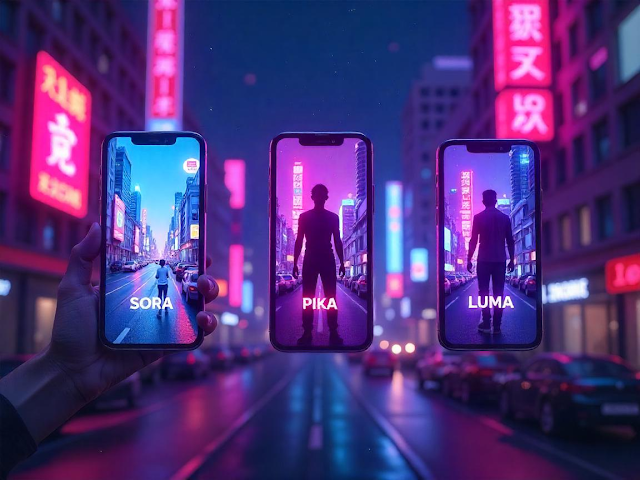BREAKING: OpenAI's Sora just changed video creation forever. See how it compares to Pika & Luma AI tools - and how Americans are cashing in with AI videos in 2025.
Imagine typing a sentence like "A robot dancing in the rain, neon lights reflecting on wet streets"—and watching it come to life as a high-definition video in seconds. This isn’t science fiction anymore. Thanks to AI video tools like Sora, Luma AI, and Pika Labs, anyone can now create stunning videos without cameras, actors, or a Hollywood budget.
But here’s the real question: Are these tools just a fun gimmick, or will they actually replace human filmmakers?And more importantly—how can you use them to grow your audience or even make money?
Let’s get started!
A year ago, AI-generated videos looked like a glitchy video game. Today, they’re nearly indistinguishable from real footage*. What changed?
Better AI models (like OpenAI’s Sora) trained on millions of real videos
Faster processing – What took hours now takes seconds
More creative control – Users can tweak lighting, camera angles, and styles
1. Sora (OpenAI) – The most advanced, producing 60-second ultra-realistic clips (not yet public).
2. Luma AI – Best for 3D environments (great for product demos).
3. Pika Labs – Free, easy-to-use, and perfect for animated social media clips.
Fun Fact: A recent AI-generated commercial for a fictional energy drink went viral—with many viewers believing it was real!
Not all AI video tools are the same. Here’s a quick real-world comparison:
OpenAI’s Sora
✔ Best for: Blockbuster-style scenes, ads, short films
✔ Strengths: Unmatched realism, smooth motion
✔ Limitation: Still in private testing (no public access yet)
Luma AI
✔ Best for: 3D product shots, real estate tours
✔ Strengths: Scans real-world objects well
✔ Limitation: Shorter clips (10-20 seconds)
Pika Labs
✔ Best for: YouTube shorts, memes, anime-style videos
✔ Strengths: Free, no waitlist, easy for beginners
✔ Limitation: Lower resolution than Sora
My Take:If you want to experiment today, try Pika. If you’re a business, watch Luma. If you’re ready for the next level, wait for Sora.
I asked a filmmaker friend what he thinks—his response? AI won’t replace us, but people using AI will.
Where AI Excels:
✅ Cost savings– No need for actors, locations, or reshoots
✅ Speed – Generate a week’s worth of content in an hour
✅ Experimentation – Test crazy ideas without budget limits
Where AI Falls Short:
❌ Emotional depth – Can’t replicate human storytelling
❌ Unpredictable errors– Sometimes adds extra limbs or weird physics
❌ Ethical issues – Deepfake and copyright battles are looming
The Verdict? AI is a powerful assistant, not a replacement. The best creators will use it to enhance their work, not replace it.
Forget theory—here’s how people are cashing in right now:
1. Sell AI-Generated Stock Footage
Sites like Pond5 and Artgrid now accept AI clips. One creator makes $300/month uploading "future city" and "sci-fi" backgrounds.
2. Run an AI-Powered YouTube Channel
Example: "Historic Battles Reimagined with AI" (a channel using AI to recreate ancient Rome gets 50K views per video).
3. Offer "AI Video" Freelance Services
Fiverr gigs like "I’ll create a 15-second AI ad for your business" sell for $50-$300 each.
4. Create Viral Instagram/TikTok Clips
Trending niches: AI celebrity parodies, dream travel destinations, "what if" scenarios (e.g., "If smartphones existed in 1980").
5. Teach Others How to Use AI Video
Online courses on Udemy or Skillshare about AI video editing are selling fast.
By 2025, experts predict:
- AI-generated full movies (Netflix already experimented with this)
- Real-time video editing (change an actor’s clothes with a text prompt)
- Personalized ads (a shoe ad that automatically fits the viewer’s style)
The line between real and AI-generated will keep blurring.
Q1: Is AI video legal? Can I get copyrighted?
A: It’s a gray area. Avoid generating clones of real actors or brands. Stick to original concepts.
Q2: When will Sora be available to the public?
A: OpenAI hasn’t announced a date yet—likely late 2024 or early 2025.
Q3: What’s the best free AI video tool right now?
A: Pika Labs (no waitlist) or Runway ML (free tier available).
Q4: Can AI video tools generate voices too?
A: Yes! Tools like ElevenLabs can add realistic voiceovers.
Q5: Will YouTube demonetize AI-generated videos?
A: Currently, no—as long as the content is original and follows guidelines.
AI video tools are like the early days of Photoshop—clunky at first, but soon everyone will be using them.
If you’re a:
- Content creator→ Start experimenting with Pika or Runway
- Business owner → Explore AI ads to cut production costs
- Curious techie → Follow Sora’s release—it’s a game-changer
What’s your take? Excited about AI video, or worried about its impact? Let’s discuss in the comments!


.jpg)



Post a Comment
Thank you for your feedback. Stay with us.